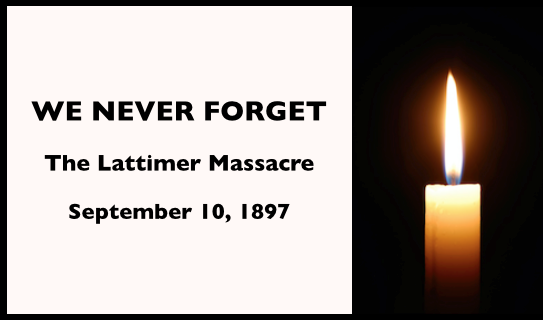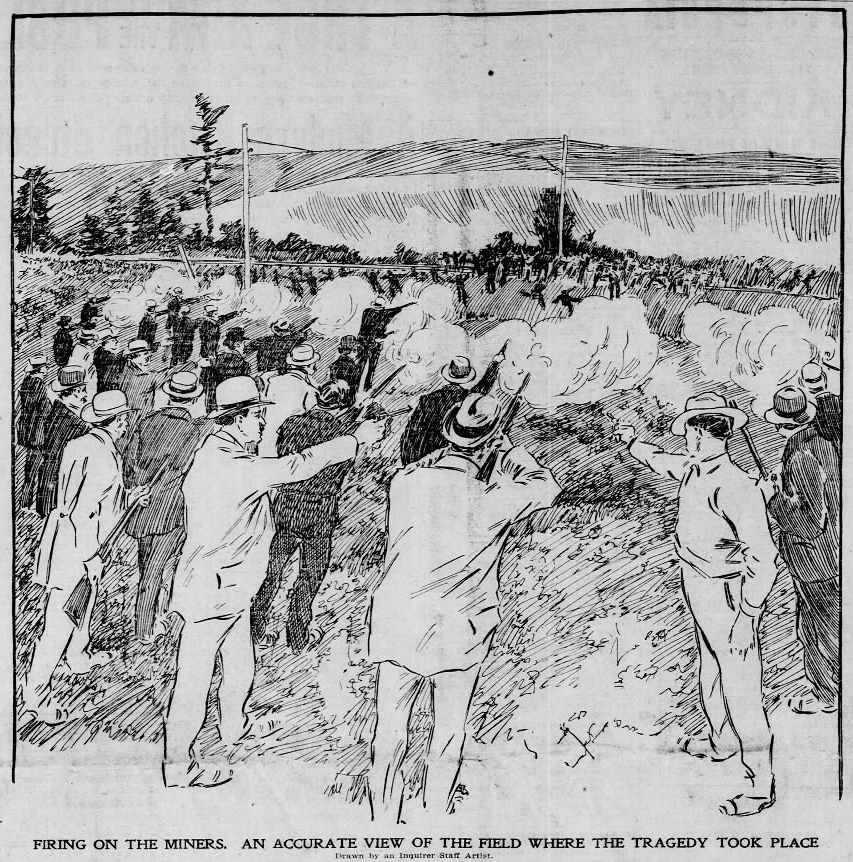Pray for the dead
and fight like hell for the living.
-Mother Jones

From the Locomotive Firemen’s Magazine of March 1898:
EDITORIAL ETCHINGS
The Lattimer Massacre.
—–
[…..]
The trial of Sheriff Martin is in progress at the present writing, and there are few who believe that justice will prevail. No matter that scores of witnesses have sworn to the details of the murder, but few doubt that long ago arrangements have been made by the defense for the introduction of other evidence which will defeat justice. It is known that the great detective agencies stand ready at any time to furnish “evidence” as well as thugs to further the ends of those who are able and willing to pay for such evidence,
At the beginning of the trial, John McGahren, of Wilkesbarre, one of the counsel retained by the citizens of Hazleton who hope for justice, said in his opening address to the jury:
This case has no parallel in this Commonwealth, or in this country. It is a case of highest importance, not only to the defendants, but to the people of the Commonwealth.
You are to try the case without sympathy for the defendants or for the persons slain [at Lattimer, Pennsylvania, on September 10, 1897]. Their condition, rich or poor, high or low, native or foreign, must not be considered by you. There will be questions of law in this case as well as of fact. It will be for His Honor to define for you not only the rights of those who are slain, but the duties of the sheriff and his deputies.
The counsel, after referring to the law, set forth what the prosecution proposes to prove by witnesses, as follows:
On the night preceding the killing these strikers held a meeting. They worked in the mines. They were dealing in the company’s store. They were charged a high price for powder. They held a meeting of their union in a peaceable, law-abiding, orderly way in Harwood. They resolved in a lawful way that they would march next day to Lattimer, and in a lawful way invite their fellow-workmen to join them. It was announced that they should go unarmed; that they should carry no guns, clubs, axes, knives or other weapons. All this was done in an open, lawful way, not clandestinely. They had a right under the law to seek redress.
Next day two hundred and fifty of these men marched from Harwood in broad day light in an orderly, peaceable manner. At Cranberry they were joined by others. At West Hazleton the sheriff and his deputies were arrayed. There were many witnesses who saw these men approach, unarmed, and the sheriff waiting with his deputies, with guns loaded. These unarmed men were marching in a lawful way, carrying the American flag, the emblem under whose protection they lived. The sheriff told them to go home. Two or three young men who understood English told the sheriff that they were going to Lattimer unarmed and on a peaceful errand.
We have two witnesses, not strikers, who heard this. Some of the deputies acted in a most unlawful manner—pushed the muzzles of their guns against the breasts of these unarmed men, and drove them off the highway. They even threatened the citizens standing by, telling them that if they did not get out of the highway they would shoot them.
The sheriff stood there with two revolvers. He did not try to arrest anybody. Imperiously he ordered everybody to go away. One deputy took his gun and beat a poor fellow on the head who was carrying the American flag. He hit him again with the gun and broke his arm.
The flag was taken from him and torn to shreds. The man wiped his bleeding face with the pieces of the flag. The Burgess of the town besought the sheriff to let the men alone. He showed the men how they could go by another street and across lots to Lattimer. The men went.
A car was in waiting for the deputies, but they had to get another car to carry them all. In the second car were some passengers. They heard one deputy say: “We’ll see what we can do at Lattimer. I’ll bet I can drop six.” Another said: “I’d like to get a chance to pop some of them.”
At Lattimer, when the cars arrived, a witness said to Edward Turnbach, one of the deputies, who was hot and dusty: “I suppose this is the hardest day’s work you’ve done in some time.”
Turnbach replied: “I don’t know what in hell the sheriff means by taking us around all day without giving us a chance to shoot these fellows.”
These peaceful men, who had marched more than four miles in the heat and dust, came on four abreast. The sheriff marched out against them, revolver in hand. We will show that the sheriff arranged the men so that they could, with their sixteen shot rifles, rake the strikers from end to end of their lines. The sheriff asked: “Where are you going?” The men replied: “We are going to Lattimer, unarmed, on a peaceful errand.”
The sheriff answered: “No matter where you are going, you must go home.”
The sheriff pointed his revolver at a poor, unarmed man. The man, with the instinct of self-preservation, seized the sheriff’s wrist. The sheriff broke away and seized another man.
He shot him in the side—shot the man who was carrying the American flag.
A deputy named Price left the others and came forward ten or twelve feet. The other deputies cried, “Come back, Price, or we’ll shoot you, too!” Price went back and then two shots were fired from among the deputies. The strikers at once ran in every direction for shelter.
Then the shots came fast. I never heard of such butchery in my life. These men who had left the road, running through the woods, running toward the school house, were butchered as they ran. That was not all. Some of the deputies climbed up the bank to the track of the electric railroad and shot across the fields at the fleeing men. One of the men who had been shot in the leg crawled into an iron pipe to hide. He was killed. One man was shot five times through the head. Only one of those shots struck while he stood. One man was killed by a deputy one hundred yards away from where the strikers first stood. Nineteen men were killed and thirty-eight wounded, and nearly all of them were shot in the back as they were running away.
These men, unarmed and peaceful, on a lawful errand, had every right to expect protection from the sheriff. But the high sheriff of this county took his deputies to that place to shoot these men. He did not try to make an arrests. The citizens came out and gave water to the wounded and carried them away. The deputies stood and looked at them, smoking their cigars.
Citizens told the deputies they had committed murder. They made no denial. Joseph Costello went over from the hotel at Minersville to help the wounded at Lattimer. He found a man lying on the road, bleeding and groaning and crying for water. Costello said to a deputy sheriff named Hess, who was prominent in the sheriff’s posse: “This is an outrage. Why did you do this?”
Hess raised his gun to his shoulder, pointed it at Costello’s breast, and said: “If you say anything more I’ll do the same to you.”
We will prove that these men, unarmed and peaceful, were shot down, butchered like sheep in a slaughter-house.
We will prove to you that nineteen men were killed and thirty-eight wounded. When we have proved these facts to you we shall say, and we shall expect His Honor to say, that these men had a right to organize, a right to march, and a right to use the public high ways. We will then expect you to do your duty and to vindicate these men and find the defendants guilty.
And reports that come from the trial show that the prosecution has proved “beyond reasonable doubt” nearly everything they said they would prove—but who is there, in all the broad land, who believes the assassins will be given the sentence they deserve? If, by chance, the verdict should be against them, all the powers of the courts—State and Federal–stand between them and their just deserts. It would never do for the mine owners of Pennsylvania to allow the “officers of the law” to be punished for protecting their property. Not much!
———-
[Drawing of Lattimer Massacre added.]
SOURCES
Brotherhood of Locomotive Firemen
-and Enginemen’s Magazine, Volume 24
Brotherhood of Locomotive Firemen and Enginemen, 1898
https://books.google.com/books?id=lY9IAQAAMAAJ
Edition of March 1898
https://play.google.com/books/reader?id=lY9IAQAAMAAJ&printsec=frontcover&output=reader&hl=en&pg=GBS.PA219
“Editorial Etchings: The Lattimer Massacre”
Re trial of Sheriff Martin and deputies:
https://play.google.com/books/reader?id=lY9IAQAAMAAJ&printsec=frontcover&output=reader&hl=en&pg=GBS.PA273
Description of Lattimer Massacre here:
https://play.google.com/books/reader?id=lY9IAQAAMAAJ&printsec=frontcover&output=reader&hl=en&pg=GBS.PA274
Sept 10, 1972
Lattimer Massacre Historical Marker
http://explorepahistory.com/hmarker.php?markerId=1-A-3BA
IMAGE
WNF Lattimer Massacre, Philly Inq -p1, Sept 12, 1897
https://www.newspapers.com/image/168032656/
See also:
Hellraisers Journal, Tuesday February 22, 1898
Wilkes-Barre, Pennsylvania – Gunthugs with Badges on Trial
From the Appeal to Reason: “The Hazelton Massacre;” Report on Trial of Sheriff & Deputized Gunthugs
The New York Times of March 10, 1898:
“Lattimer Murder Trial;
Sheriff Martin and His Deputies,
Charged with Unlawfully Killing Strikers,
Declared Not Guilty.”
https://timesmachine.nytimes.com/timesmachine/1898/03/10/102087111.pdf

